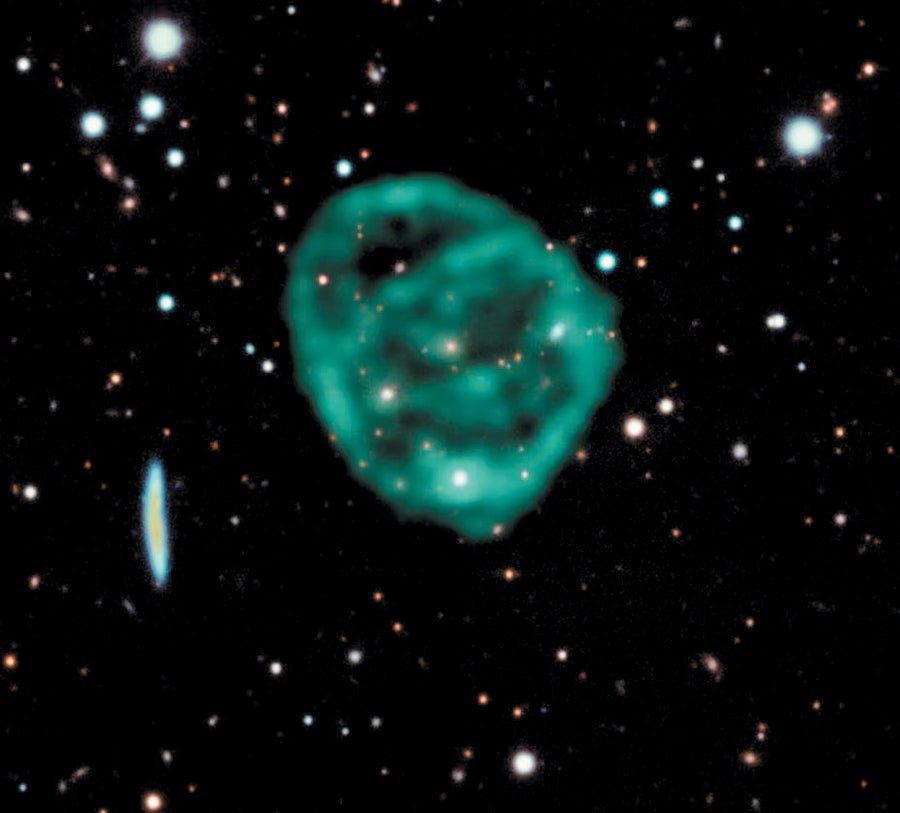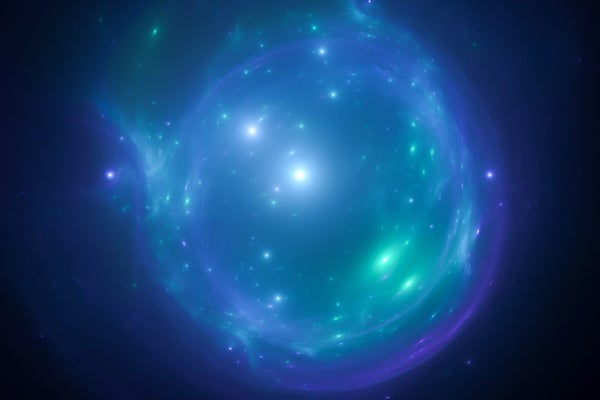It’s rare these days for astronomers to find a new class of object in the heavens. After all, we’ve been searching the skies for centuries, so all the easy stuff has already been found.
Adding new capabilities to our searches does tend to result in new discoveries, however. Looking in different wavelengths of the electromagnetic spectrum, for example, is a good way to uncover novel things because different objects emit light in different ways.
Objects in newly discovered classes also tend to be faint because, again, bright objects will have been spotted already. This fact is why identifying something completely new is unusual. It’s also why such findings can be baffling—by definition, we’ve never seen anything like them before.
On supporting science journalism
If you're enjoying this article, consider supporting our award-winning journalism by subscribing. By purchasing a subscription you are helping to ensure the future of impactful stories about the discoveries and ideas shaping our world today.
In 2019 astronomers stumbled on just such a thing when they found multiple examples of a previously unknown kind of structure. The objects turned up in a pilot survey using the at-the-time newly completed radio telescope called the Australian Square Kilometer Array Pathfinder telescope (ASKAP), a collection of 36 radio dishes, each 12 meters wide, located in Western Australia.
The newfound celestial objects were relatively big and circular—a common shape for astronomical bodies. When something out there looks circular, it’s very likely that we’re actually seeing a spherical shell, like a soap bubble. Near the middle of the bubble our line of sight goes through only a small amount of material, but near the edges that path intersects more of it. If the material glows, then it will look like a circle from any viewing direction. Dying stars that are blowing off winds of gas tend to make these kinds of structures, and many examples are known.
These new objects in the ASKAP survey, however, didn’t correspond to any previously known structure, didn’t have an obvious source and, outside of radio emission, were invisible in wavelengths of light. Lacking any obvious mechanism for their creation, astronomers dubbed them ORCs: odd radio circles. Honestly, I give them credit for coming up with such a brief, descriptive moniker (and for presumably being fans of J.R.R. Tolkien). The discovery paper, printed in Publications of the Astronomical Society of Australia, lists four such ORCs.

From “MeerKAT Uncovers the Physics of an Odd Radio Circle,” by Ray P. Norris et al., in Monthly Notices of the Royal Astronomical Society, Vol. 513, No. 1; June 2022. Published March 24, 2022 (CC BY 4.0)
The very first ORC seen, called ORC 1 (of course), provided a clue to its origin. Searching images from other telescopes, the astronomers found an object emitting visible and infrared light right at the ORC’s center. Later observations indicated it’s an elliptical galaxy about five billion light-years from Earth. If it’s the source of ORC 1, this first-of-its-kind odd celestial circle is a staggering two million light-years across—more than 15 times wider than our Milky Way galaxy—making it vast indeed. It’s also possible, however, that this galaxy instead is just coincidentally located near the apparent center of ORC 1 in the sky.
Worse, the other ORCs described in the discovery paper are even weirder. ORCs 2 and 3 are roughly the same size in the sky and happen to be so close together that they’re nearly touching, which strongly implies they’re related to each other in some way. But whereas ORC 2 is ring-shaped and bright, ORC 3 is faint and an evenly filled circle more like a disk. If they’re related, then why are they so different? There are several galaxies apparently close to them, but again these objects occupy a lot of real estate in the sky, so the odds of coincidentally finding galaxies in proximity to them are good.
Astronomers have found more ORCs in the years since those initial discoveries, and some of them also appear to have a galaxy in their center, which does seem to strengthen the correlation. If those galaxies really are in that position, then those ORCs are also in the million-light-year range in size.
If this connection is real, what physical mechanism is creating the ORCs? Ideas abound. One possible driver is a supermassive black hole. As far as we can tell, every big galaxy has one of these monsters at its heart. As matter falls in, it piles up around the point of no return in a huge disk. Strong magnetic fields that spin like a tornado near the center can launch incredibly powerful beams of matter and energy that scream away from the black hole at high speed. A 2024 study published in the Astrophysical Journal shows that these beams can inflate the gas that exists between galaxies, creating structures very much like the ORC observations.
Not all ORCs are created equal, though. In correspondence published last year in the journal Astronomy and Astrophysics, astronomers reported they had found diffuse x-ray emission at the location of an ORC they dubbed Cloverleaf, and its spectrum indicated that the high-energy light comes from hot gas typically found in low-mass galaxy groups that are somewhat heftier than our own Local Group (of which the Milky Way and Andromeda galaxies are the biggest members). This would put the ORC about 600 million light-years from Earth.

The MeerKAT image of ORC 1, superimposed on optical data from the Dark Energy Survey.
“MeerKAT uncovers the physics of an odd radio circle,” Ray P Norris et al., Monthly Notices of the Royal Astronomical Society, Vol. 513, Issue 1, June 2022, Pages 1300–1316, Published March 24, 2022 (CC BY 4.0)
The structure of the Cloverleaf emission is somewhat irregular, displaying a patchiness that is usually associated with the collision and merging of two galaxy groups. Such a catastrophic event can dump a lot of energy into the gas around the galaxies, again creating an expanding wind that can take on a roughly spherical shape. An ORC is born.
If this interpretation of the Cloverleaf is correct, it indicates there’s more than one way to make an ORC. These weird objects may in fact reflect a wide range of physical structures and distinctly differing origins. Another object, first reported in a 2022 paper, bears a resemblance to the original ORCs but lacks a central galaxy or galaxy cluster and appears as a ring in ASKAP images. Its location, though, is suspicious: it’s just three degrees from the edge of the Large Magellanic Cloud, or LMC, a satellite galaxy of the Milky Way. An association with the LMC would mean this ORC is only 160,000 light-years from us, which would make it only about 150 light-years in diameter. That would imply an entirely different formation history, making this ORC a likely supernova remnant, the expanding debris from a star that exploded long ago. What’s odd is that it’s outside the LMC, where stars are sparse. Sometimes stars do get ejected from galaxies, though; they can get catapulted away if they pass close to a massive black hole, for example, or if their companion star in a binary system they were once part of exploded, flinging them away at high speed.
It looks like the ORC category can encompass several different kinds of objects. That’s not too surprising; as we have discovered time and again in astronomy, phenomena that all look similar can have radically different causes. Some supernovae are from high-mass stars that exploded when their cores collapsed at the ends of their lives, whereas others are from already dead white dwarfs that accumulated enough matter on their surface to cause a catastrophic star-wide thermonuclear explosion. Gamma-ray bursts can be caused by extremely massive stars exploding or by two tiny but superdense neutron stars colliding. The list of coincidental similarities in a class of objects goes on and on.
Remember, the term “ORC” is descriptive, not explanatory. Some ORCs may be from galaxy-group collisions, others from exploding stars and still others from supermassive black hole belches. Although astronomers have studied ORCs for several years now, these objects are still part of a brand-new class, meaning we’re likely to have more theoretical explanations for them than we do actual examples to study in the sky. More observations should help astronomers classify them, and, as always, the hope is to categorize them, explain them and learn how they work.
